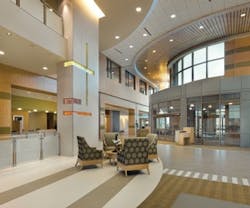Every designer is aware of the durability, clean looks and easy maintenance provided by tile, which is why it is such a popular choice in high-traffic facilities that serve the public. But advances in tile designs, sizes and formats have also made it a popular choice in truly demanding commercial environments, such as hospitals like the Indu & Raj Soin Medical Center (IRSMC), located in Beavercreek, Ohio.
Named after philanthropists who donated a generous sum of money towards the facility’s construction, the IRSMC is a new full-service 259,000-square-foot hospital and the centerpiece of the Mills-Morgan Medical Campus. One of eight Kettering Health Network facilities serving Southwestern Ohio (an area which covers both Dayton and Cincinnati), plans for this ambitious project were announced in mid-2009. The facility officially opened its doors in February of this year.
Danis Building Construction Company, a longtime supplier to Kettering Health Network, was selected to be the project’s construction manager, while renowned architectural firm HOK was contracted to design the actual structure. California-based healthcare interior design expert, Jain Malkin Inc., was chosen to create the interior themes. Immediately, the team set out to create a facility that would be both as attractive as it is functional—with tile specification as a cornerstone to its success.
“To say this project was a grandiose exercise would be a gross understatement,” says Jim Albertson, project director at Danis. “It was a very big undertaking with very unique, well thought-out design treatments—especially the tile installation, which included intelligent interior schemes for both vertical and horizontal surfaces. To make this tile installation happen, we made the decision to do something rather unusual.”
Because of the job’s size and tight deadlines, Danis made the decision to hire two tile contractors.
One was tasked with handling the tile installation in the lower walkout level ‘low-rise’, while the other was assigned tile work in the six-story bed tower. “Both of these companies were highly professional, reputable firms, and they worked with tile material provided from Fullerton, Calif.-based SpecCeramics Inc., whose people assisted us in monitoring the logistics. From the get-go, this arrangement seemed to work out nicely,” Albertson adds.
Large format porcelain tile was specified across 68,000 square feet of the project, the bulk of which featured sizes from 24 by 48 inches to 24 by 12 inches. The tile was produced by the Italian manufacturer, Caesar Ceramiche.
“The expansive size of this project called for larger tile,” says Ben Friesen of SpecCeramics. “We’ve had a longtime relationship with Jain Malkin Inc., and clearly the firm knows how to specify tile for healthcare environments.”
Kelly Kreuzinger CID, LEED AP, EDAC, senior interior designer at Jain Malkin Inc. found two Caesar Porcelain products, Feel and More, to be ideal choices for the hospital. “There were definite reasons why these tile materials were specified,” says Kreuzinger. “To begin with, we were looking at a large installation that included walls with a back-lit water feature. The scale of the space warranted larger scale tile products.”
Kreuzinger explains that tile selection is a three-part process that encompasses:
- Considering the aesthetics of the material
- Gauging the look and feel of the space, which ultimately dictates the style of the surfacing product
- Taking into account the tile’s performance aspects
“We wanted a fresh, nature-inspired look,” Kreuzinger adds. “For the water feature, the water coming down is presented visually not unlike a Yosemite National Park waterfall cutting through stone. We wanted a clean and crisp tile that evoked a feeling of stone. Furthermore, when specifying product, we kept in mind the younger middle class demographic to which the hospital would be targeting. This ‘Starbucks generation’ population base prefers contemporary designs. That’s another reason why we selected the Caesar tile material.”
a case based on evidence
Jain Malkin Inc. is a leading proponent of evidence-based design, a strategy that enhances safety, quality and the patient experience by basing decisions about the built environment on credible
research to achieve the best possible clinical outcomes. The firm’s influence on the interiors of the Indu & Raj Soin Medical Center in order to improve patient care and recovery times cannot be understated.
“The creative work coming from Jain Malkin was, without a doubt, a great example of evidence-based interior design,” says Albertson. “The people at that firm know how to choose colors, textures and combinations of surfacing materials that provide a healing environment for patients in many ways. When patients first walk into the Indu & Raj Soin Medical Center, it feels more like a Hilton than a hospital to them. This rationale creates an immediate comfortable, positive reaction which is step one for their recovery.”
High-performance tile materials were used in the public restrooms and patient bathrooms, in addition to the walls and floors of the expansive lobby and corridor areas. The flooring was cleverly designed with a very unique wayfinding scheme. Tile and carpeting are installed in the hospital's public areas and indicate general walking spaces; the use of heat-welded vinyl sheet flooring indicates spaces for hospital officials, doctors and patients only.
In addition, some of the larger Caesar wall tiles specified for vertical public spaces were constructed with porcelain bodies and embedded with stainless steel accent bars. To add some pizzazz, glass accent tiles were also installed in patient bathrooms and public restrooms.
“The nicest thing about this grand scale installation was that from the very beginning, everything was done at the highest professional degree by everyone involved,” says Dave Leal, president of SpecCeramics. “When we look back and think about sizable commercial tile projects which we were proud being part of, clearly the Indu & Raj Soin Medical Center falls into that category.”
Ron Treister is the president and owner of Communicators International, a marketing communications firm with a strong niche in the ceramic tile and stone industry headquartered in Portland, Maine, with satellite offices in Chicago and Springfield, Mo.
